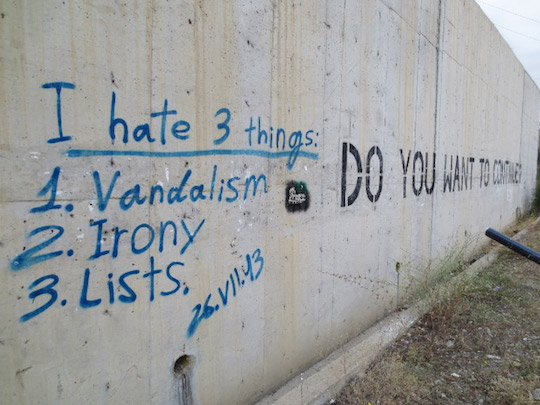One of the problems with rhetorical irony is that sometimes people don’t get it. That’s also a major source of its appeal. When irony works, the reader sees it but holds out the possibility that someone else does not. This effect is a big part of the fun, even though plenty of satirical writing cheats it by deploying irony in a way few readers could miss. The trick is to maintain a sort of plausible deniability. Irony doesn’t have to actually fool anybody, but we as knowing readers must be able to fool ourselves into believing it might. Satire can therefore be pretty heavy-handed, so long as the irony is not explicitly signaled.1 I mention this to introduce a convention of irony Twitter that has bled over into other sub-comunities: the practice of signaling irony with typographical errors. For example:
Is it cheating to explicitly signal irony in this way? Consideration after the jump.
First of all, you should follow @kept_simple, one of many funny strangers who have come to my attention through the massive productivity vortex that is Twitter. You should follow everybody screenshotted in this post. Second, the screenshot above is a straightforward example of the convention we’re discussing. Ol’ KS is referring to a frustration common among basketball fans: watching a player break away from the defense, only to stop to beyond the three-point line but far from the basket, for a shot that combines the difficulty of the three with the low point value of the layup. The use of “love too” instead of “love to” signals that KS does not actually love this behavior. He is being ironic. “Love too” is a common way to signal irony through a typo. Here’s Willy:
This use of irony is slightly different from KS’s, in that the figurative meaning is not a pure negation of the literal one. Rather than expressing dislike for Tweeting and mentions, Willy is conveying a self-deprecating weariness: he does like to tweet and get @’s, but he also finds this behavior kind of gross and depressing.2 As with KS’s tweet, though, he does not want what he’s saying to be taken at face value. He is being wry or arch—something he might signal in conversation with tone of voice or a raised eyebrow. On Twitter, those tools are unavailable, so he uses the “love too” construction instead.
“Love too” is not the only phrase so used. Pretty much any typo can signal irony, which sometimes leads to ambiguity. Typos happen by accident, too, so how do you know? Here’s Felix Biederman of Chapo Trap House:
I read the typo in this tweet as deliberate, since ironic support for “fathers’ rights” and outrage at family court judges is a running joke in Biederman’s work. The conceit is that none of these things listed exists, but the irony here is complicated, since he probably really doesn’t respect moderate Republicans.3 This more complex or maybe just inconsistent irony is reflected in the “an” for “a” typo, which is not so clear a signal as “love too.”
Still, it’s either an explicit indicator of irony or it isn’t. In this way, the typo differs from classical signals of irony like exaggeration, mockery, or double meanings. All those devices are subjective. You might embarrass yourself, but you can always argue that hyperbole is sincere or that a double meaning is only a coincidence. But a typo is binary. You can argue whether it was intentional, but once that’s established, it becomes the one thing satire cannot abide: an explicit declaration of irony. You can hint, and you don’t have to hint subtly. But you cannot simply say you’re being ironic, or you spoil the fun. Is the typo signal therefore a cheat on the same order as the Sarc Mark?
Maybe. But it’s worth noting that you have to be familiar with the conventions of irony Twitter to recognize the typo as an indicator of irony. Large portions of these users’ followers may know the convention, but that’s still a fairly small portion of the overall Twitter audience. Although the typo is more explicit than classical methods of signaling irony, it performs the same essential function. It allows those who recognize the irony to reasonably believe that others won’t.
Awareness of the typo convention is therefore structurally similar to the classic division between people who got irony and people who didn’t: having an education. During most of the heydays of satirical prose, the people who were educated enough to recognize and understand exaggeration, mockery and double meaning made up a small portion of the overall audience. Knowing the customs of irony Twitter today is like having a liberal education in renaissance Italy: an arbitrary distinction that confers the thrill of in-group membership.
Of course, you can apply your education to lots of useful, real-world pursuits, whereas a thorough understanding of Twitter will leave you sad and useless. But a liberal education and a familiarity with the typo convention of irony Twitter serve the same function within the project of satire. They limit understanding of your joke to a select audience, who enjoy the thrill of conspiracy against an imagined, dumber reader







